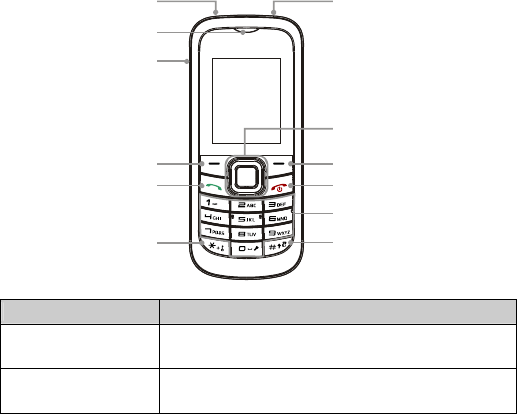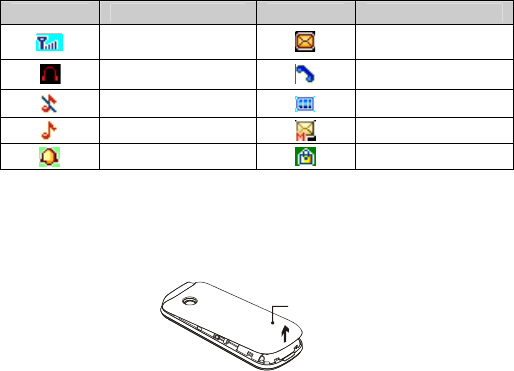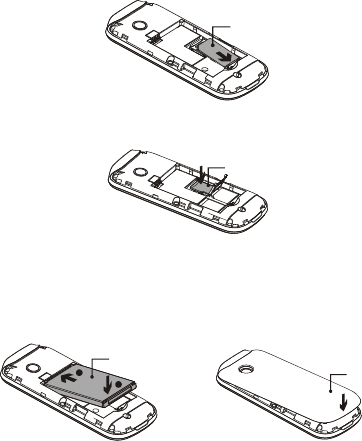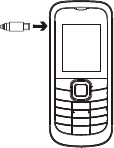ZTE GR255 GSM (GPRS) Dual-Band Digital Mobile Phone User Manual ZTE G R255 UserMan
ZTE Corporation GSM (GPRS) Dual-Band Digital Mobile Phone ZTE G R255 UserMan
ZTE >
user manual
ZTE-G R255
GSM (GPRS) Dual-Band Digital Mobile Phone
LEGAL INFORMATION
Copyright © 2012 ZTE CORPORATION.
All rights reserved.
No part of this publication may be excerpted, reproduced, translated or
utilized in any form or by any means, electronic or mechanical, including
photocopying and microfilm, without the prior written permission of ZTE
Corporation.
The manual is published by ZTE Corporation. We reserve the right to
make modifications on print errors or update specifications without prior
notice.
Version No.: R1.0
Edition Time: 2012.09.01
3
Table of Contents
SECURITY ................................ 4
LIMITATION OF LIABILITY .... 10
KEY FUNCTIONS ................... 11
LOCKING AND UNLOCKING
THE KEYPAD ......................... 12
INTERFACE ICONS ............... 13
INSTALLING THE SIM/SD
CARD AND BATTERY ............ 13
REMOVING THE BATTERY ... 15
CHARGING THE BATTERY ... 15
POWERING YOUR PHONE
ON/OFF ................................... 16
TURNING THE TORCH ON/OFF
................................................ 16
TEXT INPUT ........................... 16
ADDING CONTACT TO THE
PHONEBOOK ......................... 17
MAKING AND RECEIVING
CALLS .................................... 18
SENDING AND RECEIVING
MESSAGES ............................ 18
USER PROFILES ................... 19
CALL CENTER ....................... 20
SETTING YOUR PHONE ........ 20
USING ORGANIZER .............. 21
HOW TO PLAY GAMES ......... 21
HOW TO TAKE A PHOTO ...... 21
HOW TO PLAY MUSIC ........... 22
HOW TO USE FM RADIO ...... 22
USING SERVICES .................. 22
FCC REQULATIONS .............. 23
RF EXPOSURE
INFORMATION(SAR) ............. 24
4
Security
To protect your mobile phone from illegal use, take the security
measures as follows:
Set PIN codes of the SIM card.
Set handset lock code.
Set call restrictions.
Safety Precautions
This section includes some important information on safe and efficient
operation. Please read this information before using the phone.
Operational Precautions
Please use your phone properly. When making or receiving a call,
please hold your phone as holding a wireline telephone. Make sure
that the phone is about one inch from your body when transmitting.
Do not touch the antenna when the phone is in use. Touching the
antenna area affects call quality and may cause the phone to operate
at a higher power level than needed.
Some people may be susceptible to epileptic seizures or blackouts when
exposed to flashing lights, such as when watching television or playing
video games. If you have experienced seizures or blackouts, or if
you have a family history of such occurrences, please consult your
5
doctor before playing video games on your phone or enabling a flashing-
light feature on your phone. (The flashing-light feature is not available
on all products.)
Keep the phone out of the reach of small children. The phone may
cause injury if used as a toy.
Precautions While Driving
Please pay attention to the traffic safety. Check the laws and regulations
on the use of your phone in the area where you drive. Always obey
them.
Use hands-free function of the phone, if available.
Pull off the road and park before making or answering a call if conditions
require.
Precautions for Medical Devices and Facilities
When using your phone near pacemakers, please always keep the
phone more than eight inches (about twenty centimeters) from the
pacemaker when the phone is switched on. Do not carry the phone in
the breast pocket. Use the ear opposite the pacemaker to minimize
the potential for interference. Switch off the phone immediately if
necessary.
Some phones may interfere with some hearing aids. In the event
of such interference, you may consult your hearing aids manufacturer
6
to discuss alternatives.
If you use any other personal medical device, please consult the
manufacturer of your device to determine if it is adequately shielded
from RF energy.
In those facilities with special demand, such as hospital or health care
facilities, please pay attention to the restriction on the use of mobile
phone. Switch off your phone if required.
Mobile Phone
Please use original accessories or accessories approved by the
phone manufacturer. Do not connect the phone with any
incompatible enhancement.
Turn off your phone before you clean it. Do not use harsh chemicals,
cleaning solvents, or aerosols to clean the device or its accessories.
Do not expose your mobile phone to direct sunlight or store it in hot
areas. High temperatures can shorten the life of electronic devices.
Keep your phone dry. Any liquid may damage your phone.
Do not drop, throw or try to bend your phone or its accessories.
Do not attempt to disassemble the mobile phone or battery.
Do not charge the mobile phone without battery.
Some electronic devices are susceptible to electromagnetic interference
sent by phone if inadequately shielded. Please use phone at least 20
7
cm or as far away as you can from TV set, radio and other automated
office equipment so as to avoid electromagnetic interference.
Keep phone out of the reach of small children. Phone may cause
injury if used as a toy.
Do not put other things on the terminal to avoid overlaying radiator.
Do not connect the phone with any incompatible enhancement.
Keep the antenna free from obstructions and position the antenna
straight up. This will ensure best call quality.
Precautions for Potentially Explosive Atmospheres
Switch off your phone prior to entering any area with potentially explosive
atmosphere, such as fueling areas, fuel or chemical transfer or
storage facilities.
Do not remove, install, or charge batteries in such areas. Spark in a
potentially explosive atmosphere can cause an explosion or fire
resulting in bodily injury or even death.
Power off your mobile phone or wireless device when in a
blasting area or in areas posted power off “two-way radios” or
“electronic devices” to avoid interfering with blasting operations.
Precautions for Electronic Devices
Some electronic devices are susceptible to electromagnetic interference
8
sent by mobile phone if inadequately shielded, such as electronic
system of vehicles. Please consult the manufacturer of the device before
using the phone if necessary.
Safety and General Use in Vehicles
Safety airbag, brake, speed control system and oil eject system
shouldn’t be affected by wireless transmission. If you do meet problems
above, please contact your automobile provider. Do not place your
phone in the area over an airbag or in the airbag deployment area.
Airbags inflate with great force. If a phone is placed in the airbag
deployment area and the airbag inflates, the phone may be propelled
with great force and cause serious injury to occupants of the vehicle.
Please turn off your mobile phone at a refueling point, and the same
to the place where the use of two-way radio is prohibited.
Aircraft Safety
Switch off your wireless device whenever you are instructed to do
so by airport or airline staff.
Consult the airline staff about the use of wireless devices on board
the aircraft. If your device offers a ‘flight mode’, this must be enabled
prior to boarding an aircraft.
9
Battery Use
Do not short-circuit the battery, as this can cause the unit to overheat
or ignite.
Do not store battery in hot areas or throw it into fire. Otherwise, it
will cause explosion.
Do not disassemble or refit the battery. Otherwise, it will cause liquid
leakage, overheating, explosion and ignition of the battery.
Please store the battery in a cool dry place if you don’t use it for a long
period.
The battery can be recharged for hundreds of times, but it will eventually
wear out. When the operating time (talk time and idle time) is
noticeably shorter than normal, it is time to replace it with a new one.
Please stop using the charger and battery when they are damaged
or show evidence of aging.
Return the worn-out battery to the provider or dispose of it in accordance
with environment regulations. Do not dispose of it in household rubbish.
Please use original batteries or batteries approved by the phone
manufacturer. Using any unauthorized battery may affect your handset
performance or may cause danger of explosion, etc.
Warning: If the battery is damaged, do not discharge it. If the leakage
does come into contact with the eyes or skin, wash thoroughly in clean
water and consult a doctor.
10
Limitation of Liability
ZTE shall not be liable for any loss of profits or indirect, special,
incidental or consequential damages resulting from or arising out of or in
connection with using this product, whether or not ZTE had been
advised, knew or should have known the possibility of such damages.
The user should refer to the enclosed warranty card for full warranty
and service information.
Note: The pictures and icons shown in the manual are just schematic
drawings for demonstration of functions. If they are inconsistent with your
handset, please take your handset as the standard. If the inconsistency
exits in the manual because the handset function has been updated,
please refer to the follow-up public information from ZTE.

11
Key Functions
Function Description
Left soft key Performs the function indicated at the left bottom of the
screen.
Right soft key Performs the function indicated at the right bottom of the
screen.
Torch Handset
Earpiece
Charger interface
Left soft key
Send key End/Power key
Right soft key
4-way navigation
keys and Center ke
y
*
key # key
Alpha/numeric keys

12
Centre key Press to confirm actions and make selections.
4-Way
Navigation keys
These keys (UP, DOWN, LEFT and RIGHT) allow for
navigation through menu options and quick access to
some function menus.
Send key Press to dial a phone number or answer a call, or view
the call history.
End/Power key
Press to end a call.
Press to exit to the idle mode.
Hold to switch on/off the phone.
Alpha/numeric keys Press to enter characters 0-9, the alphabets from a-z
and symbols.
Note: In this User Manual, “press a key” means to press the key and
release it, while “hold a key” means to press the key for at least two
seconds and then release it.
Locking and Unlocking the Keypad
In idle screen, press the Left soft key and then press the * key within
two seconds to lock the keypad. The unlock method is the same.
Locking the keypad can prevent unintentional operations on it. You can
answer an incoming call with the regular operation when the keypad is
locked.

13
Interface icons
Indicator What it means
Indicator What it means
Signal strength New SMS
Headset Missed call
Silent Battery status
General New MMS
Alarm clock set Keypad locked
Installing the SIM/SD card and battery
Switch off your phone before installing or replacing the battery, SIM or
memory card.
1. Pull the back cover from the notch on the bottom and remove it.
Remove the battery cover
2. Hold the SIM card with the cut corner oriented as shown and then
slide it into the card holder with the metal contacts facing downward.
Battery cove
r

14
Insert the SIM card
3. Insert the card with the metal contacts facing down until it clicks to
the right position.
Insert the Memory card
Note: You can use memory card to expand the storage of the phone.
4. Insert the battery by aligning the metal contacts with the contacts in
the battery slot. Gently push down the battery until it clicks into
place. Then Press the cover gently back into place until you hear a
click.
Push down the battery Replace the battery cover
1
2
Battery
Battery cover
SD car
d
SIM car
d

15
Removing the battery
The lithium ion battery of the mobile phone can be immediately used
after unpacking.
1. Make sure that your mobile phone is switched off.
2. Remove the back cover.
3. Pull the battery up and remove it from the mobile phone.
Remove the battery cover Pull up the battery
Charging the battery
Your phone is powered by a rechargeable battery. For maximum battery
performance, it is recommended that you first use up the battery power
and then charge it completely. A new battery’s full performance is achieved
only after three complete charge and discharge cycles.
1. Connect your travel adapter to the left side of your mobile phone as
shown in the diagram.
Battery cove
r
Battery

16
When the battery is being charged, the display will show the animation of
a battery being filled up.
2. When the battery is fully charged, disconnect the charger.
Powering your phone on/off
Make sure that the SIM card is in your device and the battery is charged.
Hold the End/Power key to power on/off the phone.
Turning the torch on/off
In the idle screen, hold the 0 key can turn on or off the torch.
Text Input
Your phone provides the following input methods: Smart ABC/abc,
ABC/abc and numeric modes. Press the # key to change the input
modes.
17
Input Letters: In Smart ABC/abc, ABC/abc mode, press A~Z to enter
desired characters.
Input Digits: In numeric mode, press digit key once to input a digit.
Input Symbol:
Press * key to select the desired symbol (common
symbols) by pressing the Navigation keys and then press the Left soft
key or Center key to confirm it.
Input Space: Press the 0 key to input space. It does not work in
numeric (123) mode.
Delete Character: Press the Right soft key to clear a character. Hold
the Right soft key to delete all characters and clear the display.
Move cursor to left or right: Among the text, press the Left/Right
navigation keys to move the cursor to left or right.
Adding contact to the Phonebook
There are some numbers that you may want to call again and again, so
it makes sense to add these numbers to your Phonebook. You can then
access these numbers quickly and easily.
1. Go to Menu>Phonebook>Add new contact.
2. Edit the information and save it.
You can also save a number right after you’ve made or received a
phone call or a text message from someone who is not yet in your
Phonebook list.
18
To delete someone from your Phonebook list, first select the name,
then select Options>Delete.
Making and receiving calls
The most basic way to make a call is to input the number in the standby
mode and press the Send key. You can also make a call from the
Phonebook list.
To call someone: Go to Menu> Phonebook. Use the Up/Down
keys to find the name of the person you want to call. You can also
type in the first letter of the name of the person you want to call to
find the right name, and press the Send key.
To receive a call, press the Send key.
To end a call, press the End/Power key.
To reject a call, press the End/Power key.
Make sure that you are in an area with sufficient coverage to make calls.
The strength of the network signal is indicated on the Status Bar of the
screen.
Sending and receiving messages
You can use your mobile phone to send and receive messages.
Send a message
19
1. Go to Menu>Messaging>Write message>Text/Multimedia
message.
2. Write your message. For more information on input method,
see section ‘Text Input’. When you write an SMS, press
Options>Send to, and edit the recipient. When you write an
MMS, you can edit To, Cc, Bcc, Subject and content. In content
field, you can select Options and then select to insert slide,
image,video,audio and attachment.
3. When you finish writing an SMS/MMS, select to send or save the
message.
Receive a message
Upon receiving a message, the mobile phone will alert you with a
ringtone, prompt, or a new message icon.
1. Press View to open the new message. You can also go to Inbox
to read the message.
2. Use the Up/Down keys to view the message.
3. While the message is open, use Options to reply, delete, or forward
the message. You can also call back the sender.
User profiles
Go to Menu>User profiles. You can select Options>Activate to
activate a profile. Or you can select Options>Customize to edit a profile.
20
Call center
Go to Menu>Call center.
Call history
Missed calls, Dialed callsand Received calls are saved in Call history.
If the records are full, the earliest saved records will be deleted.
Also, you can delete call logs and view call timers in Call history.
Call settings
You can set call waiting, call divert and call barring and so on.
Setting your phone
You can adjust various settings of your phone. Go to Menu>Settings.
Phone settings: Set time and date, schedule power on/off, language,
display and auto update time, etc.
Network settings: Set to automatically or manually select network,
and set the preferred networks.
Security settings: Set security features to protect you from unauthorized
use of your phone and SIM card.
Connectivity: Set bluetooth and view data accout.
Restore factory settings: Enter the phone lock code to restore to the
factory settings. Some personal information might be lost if you use
this function, so be careful.
21
Note: You may be required to input the phone password in some of the
security settings interfaces. The default password is 1234.
Using Organizer
Go to Menu>Organizer.
Calendar
Go to Organizer>Calendar. The calendar of the current month will be
displayed on the screen and the current date will be marked by a
background box in a special color.
Alarm
Go to Organizer>Alarm. You can view and edit the alarm clocks
settings. You can also enable or disable the alarms.
How to play games
Go to Menu> Multimedia> Games.
Your mobile phone has classic games. Select a game and start it, you can
view Help to see the rules of the game.
Note: please take your handset as the standard.
How to take a photo
Go to Menu>Multimedia>Camera.
To take a photo: aim the camera at the object and then press the Center
22
key to take the shot.
Configure camera: press the Left soft key to configure your camera.
How to play music
Go to Menu>Multimedia>Audio player. You can play the audio in your
phone or the memory card.
How to use FM radio
Go to Menu>Multimedia>FM radio.
With the radio, you can search for radio channels, listen to them, and
save them on your device. Note that the quality of the radio broadcast
depends on the coverage of the radio station in that particular area. In
the FM radio interface, you can press the Up/Down keys to tune the
frequency, press the Left/Right keys to search the frequency, and press
the Centre key to pause. Select Options to enter the submenu.
Note: please take your handset as the standard.
Using Services
Go to Menu>Services.
In Services you can view internet content. Select Internet service. You
can perform the following operations:
Select Homepage to go to your homepage interface.
23
Select Bookmarks to access your phone’s preset websites.
Select Search or input URL to access you desired websites.
Select Recent pages to view the list of pages you recently visited.
Select Settings>preferences. Select Timeout to set timeout. If the
timeout period elapsed prior to completion of the operation or the server
is not responding, your phone will show “Connection Failed”. During
the timeout period, it will keep trying to connect until expired. Select Show
pictures to set whether or not to show the images. Select whether or
not to enable Cache and Cookies.
FCC Requlations
This mobile phone complies with part 15 of the FCC Rules. Operation
is subject to the following two conditions: (1) This device may not cause
harmful interference, and (2) this device must accept any interference
received, including interference that may cause undesired operation.
This mobile phone has been tested and found to comply with the limits
for a Class B digital device, pursuant to Part 15 of the FCC Rules. These
limits are designed to provide reasonable protection against harmful
interference in a residential installation. This equipment generates, uses
and can radiated radio frequency energy and, if not installed and used in
accordance with the instructions, may cause harmful interference to
radio communications. However, there is no guarantee that interference
will not occur in a particular installation If this equipment does cause
24
harmful interference to radio or television reception, which can be
determined by turning the equipment off and on, the user is encouraged
to try to correct the interference by one or more of the following
measures:
-Reorient or relocate the receiving antenna.
-Increase the separation between the equipment and receiver.
-Connect the equipment into an outlet on a circuit different from that to
which the receiver is connected.
-Consult the dealer or an experienced radio/TV technician for help.
Changes or modifications not expressly approved by the party
responsible for compliance could void the user‘s authority to operate the
equipment.
The antenna(s) used for this transmitter must not be co-located or
operating in conjunction with any other antenna or transmitter.
RF Exposure Information(SAR)
This mobile phone meets the government’s requirements for exposure to
radio waves.
This phone is designed and manufactured not to exceed the emission
limits for exposure to radio frequency (RF) energy set by the Federal
Communications Commission of the U.S. Government.

25
The exposure standard for wireless mobile phones employs a unit of
measurement known as the Specific Absorption Rate, or SAR. The SAR
limit set by the FCC is 1.6W/kg. *Tests for SAR are conducted using
standard operating positions accepted by the FCC with the phone
transmitting at its highest certified power level in all tested frequency
bands. Although the SAR is determined at the highest certified power
level, the actual SAR level of the phone while operating can be well
below the maximum value. This is because the phone is designed to
operate at multiple power levels so as to use only the poser required to
reach the network. In general, the closer you are to a wireless base
station antenna, the lower the power output.
The highest SAR value for the model phone as reported to the FCC
when tested for use at the ear is 1.440W/kg and when worn on the body,
as described in this user guide, is 1.460W/kg (Body-worn measurements
differ among phone models, depending upon available enhancements
and FCC requirements.)
While there may be differences between the SAR levels of various
phones and at various positions, they all meet the government
requirement.
The FCC has granted an Equipment Authorization for this model phone
with all reported SAR levels evaluated as in compliance with the FCC RF
exposure guidelines. SAR information on this model phone is on file
with the FCC and can be found under the Display Grant section of
http://www.fcc.gov/oet/fccid after searching on FCC ID: Q78-GR255.
26
For body worn operation, this phone has been tested and meets the
FCC RF exposure guidelines for use with an accessory that contains no
metal and the positions the handset a minimum of 1.5 cm from the body.
Use of other enhancements may not ensure compliance with FCC RF
exposure guidelines. If you do no t use a body-worn accessory and are
not holding the phone at the ear, position the handset a minimum of 1.5
cm from your body when the phone is switched on.
This device is compliance with SAR for general population /uncontrolled
exposure limits in ANSI/IEEE C95.1-1999 and had been tested in
accordance with the measurement methods and procedures specified in
OET Bulletin 65 Supplement C.